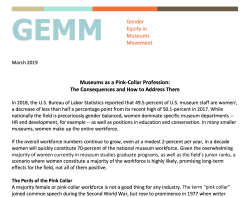The Museum Workplace & the Weinstein Effect
Posted: October 16, 2017 Filed under: Uncategorized 2 Comments
By Rosa Pineda – Own work, CC BY-SA 4.0, https://commons.wikimedia.org/w/index.php?curid=55223488
Museums aren’t known for workplace self-examination, so it’s possible the title of this piece makes you cringe. But in the wake of all the press surrounding Harvey Weinstein’s debacle, maybe it’s time to focus on sexual harassment in museums and heritage organizations.
To begin, while museums are places of imagination, creativity, and discovery, they are first and foremost workplaces. In short, they possess all the wonderful characteristics we want them to, until they don’t. And when it comes to being workplaces, they are not dissimilar from many other job sectors where one in three women is sexually harassed. Just to be clear, this is what Title VII of the Civil Rights Act defines as workplace harassment: “unwelcome sexual advances, requests for sexual favors, or other verbal or physical conduct of a sexual nature.”
In researching our book, Women in the Museum: Lessons from the Workplace, we heard numerous stories of harassment. And when we spoke, along with interviewees from the book at the AAM and AASLH annual meetings, more than half the room raised their hands when we asked if they had experienced workplace sexual harassment. So much for the polite, deferential museum world. Not to mention that two of our four panelists were included in that number, one photographed inappropriately and repeatedly until she blew the whistle on her harasser, and another told her career advancement was dependent on her having sex with her boss.
These were not the only stories. There were many more. What was particularly disturbing is that a lot of women who shared their experiences were told to keep quiet. There are variations on this theme of if-you-know-what’s-good-for-you, you-won’t-talk. They range from: “You’ll damage your career,” to “We’re taking care of it,” to our particular favorite “Well, stuff like that happens.” Really?
All of these excuses play on the reasons women are afraid to reveal sexual harassment in the first place. Many fear retaliation. What makes these situations doubly sad is that women not only fear retaliation from the abuser, particularly if that person is in a position of power–a board member or a director–but many times they are also afraid their colleagues won’t support them. In fact, according to a 2016 Harvard Business Review survey 71-percent of women who experienced workplace harassment didn’t report it. And significantly, their colleagues who witnessed the behavior also failed to report it, something that’s known as the bystander effect, meaning individuals in a group are less likely to come to someone’s aid than if they were alone.
Clearly, the museum field needs to acknowledge that harassment happens and support women who are its victims. So what can the museum field do to change this behavior and compel museum boards and directors to protect women?
- All museums and heritage organizations need to understand that sexual harassment is a form of sex discrimination that violates Title VII of the Civil Rights Act of 1964. Title VII applies to non-profits as well as for-profits and it applies whether your organization employs one person or 2,000. A civil rights violation is a civil rights violation no matter where it’s committed.
- All museums and heritage organizations need to have personnel policies that explain what employees should do in the event of sexual harassment. Check your policy today. These policies should spell out anti-retaliation provisions under state law, and more importantly, how victims file complaints with the Equal Employment Opportunity Commission, or the equivalent state agency.
- All museums and heritage organizations should understand that while the majority of sexual harassment claims are brought by women against men, Title VII protects everyone.
- All museums and heritage organizations should take sexual harassment claims seriously. Personnel policies should define sexual harassment, state that it will not be tolerated, and that wrongdoers will be disciplined or fired.
- All museums and heritage organizations should offer sexual harassment training for employees annually. If your organization is too small, join forces with another museum or non-profit to pay for the trainer. And know that if you live in Connecticut, Maine or California and employ more than 50 people, there are state laws regarding sexual harassment training.
These are not difficult or expensive fixes. Be proactive. Protect your employees and your organization.
Joan Baldwin










Great article.
The root of this issue lies with those who hold the power – the Directors and the Boards. If you are a Director or on a Board please take action against sexual harassment and encourage others in positions of power to do so too.
I’ve reported sexual harassment (and bullying) before (to my former director) only to be told that if he didn’t hear it/see it then it was “heresy” and there was nothing he could do.
William King Museum in Abingdon, Virginia, is a proactive work environment. Sexual harassment paperwork and training is a conspicuous part of the onboarding process. I can’t imagine it being any other way.